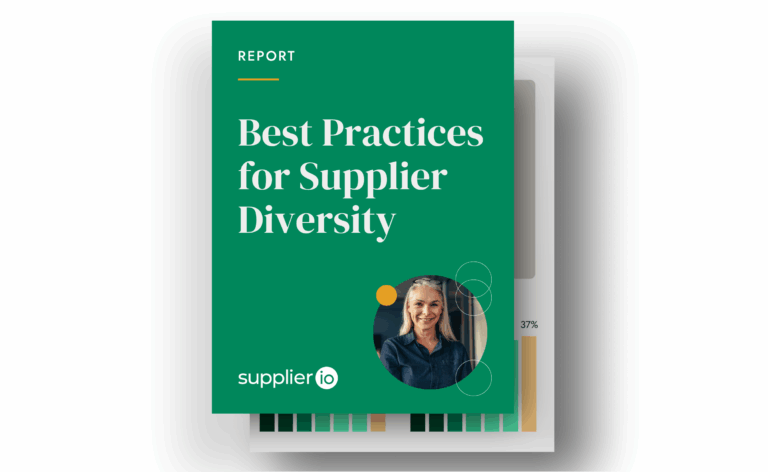A Quick Guide to Supplier Diversity Policy
An essential element of your supplier diversity program is a policy outlining what the program is, who it includes, what the program goals are, and how you will achieve those goals.

An essential element of your supplier diversity program is a policy outlining what the program is, who it includes, what the program goals are, and how you will achieve those goals. This differs from a supporting statement, which is a public-facing statement from a CEO or president expressing the company’s intention to be inclusive. The supplier diversity policy is strategic. It provides internal guidance for your supplier diversity team, encourages buy-in from stakeholders, builds public awareness of your program, and establishes expectations for suppliers.
Your supplier diversity policy should be comprehensive, but it doesn’t need to be a novel. It is a living document, updated regularly to reflect your changing goals and maturing supplier diversity program. Post this policy on your website and/or your supplier registration portal so it is easy to access internally and externally.
Here are some suggestions for how to craft your supplier diversity policy and what should be included to follow supplier diversity best practices.
Purpose
First things first, your supplier diversity policy should clearly state the purpose of your supplier diversity program. Why are you investing in supplier diversity? What does your company want to achieve with a supplier diversity program?
The answer is probably some or all of these common reasons:
- To find the best suppliers (competitive advantage and customer satisfaction)
- To demonstrate corporate responsibility (providing opportunities for marginalized communities)
- To increase sustainability (stronger, diversified supply chain)
- To promote diversity (innovation and social responsibility)
- To support the local community (economic impact and reflection of customer demographics)
Select the rationale that best fits your purpose, then include that information in your supplier diversity policy. When your purpose is clearly stated, it’s much easier to be strategic about setting goals and creating initiatives.
Parameters
An effective policy that follows supplier diversity best practices defines the parameters of your program, providing focus and structure. Suppliers and stakeholders alike need to know which diversity categories you recognize and count toward your spend goals.
The main categories are:
- Minority-owned
- Woman-owned
- LGBTQ+-owned
- Veteran-owned (including disabled veteran-owned)
- Disability-owned
- Small businesses (see note)
Including all of these categories is recommended, although you may decide to focus on increasing the number of diverse suppliers from one or two categories in the beginning.
A note about small businesses: This is the only category on the list that does not require the business to be at least 51 percent owned and operated by a member of a diverse or marginalized community. A small business is a company that is categorized as small based on revenue and/or employees as determined by the Small Business Administration’s classification standards. Some government contracts require prime contractors to subcontract with a small business.
Another parameter you need to make clear in your supplier diversity policy is whether or not you require third-party certification as opposed to self-certification. It is considered a supplier diversity best practice to require third-party certification to ensure the integrity of your supplier diversity reporting.
Third-party certification is available to qualified diverse businesses through national certifying entities such as the National Minority Supplier Development Council, Women’s Business Enterprise National Council, National LGBT Chamber of Commerce, and Disability:IN. However, hundreds of other certifying bodies with similarly stringent requirements also exist. Most cities, states, and municipalities have their own certification processes as well as other private and government certifying agencies.
When crafting your supplier diversity policy, be up front about what types of certification you will accept.
Goals
It’s difficult—and inefficient—to work toward goals if you haven’t clearly stated what those goals are. Your supplier diversity policy clearly outlines the desired outcome for your supplier diversity program in both tangible and intangible results, aiding in decision-making and aligning efforts across the organization.
For example, your tangible goals might include increasing diversity spend, either to a specific dollar amount or a percentage of overall spend.
Perhaps you want to track your economic impact, translating spend with diverse businesses into real-world results and pledging to help drive a certain percentage increase in jobs within a diverse supplier’s community.
Your intangible goals might be in the area of supplier development, such as increasing supplier capacity or increasing your company’s innovation, sustainability, and competitiveness within the marketplace.
Following the social unrest of 2020, many companies are choosing to make at least some of their supplier diversity goals public. This can help improve brand reputation and increase consumer awareness of your company’s commitment to diversity, equity, and inclusion.
Whether or not you choose to publicize your supplier diversity goals, make sure they are specific, attainable, measurable, and clearly communicated in your supplier diversity policy.
Strategy
Once you’ve stated your goals, how will you achieve them? Strategize the steps needed and include them in your supplier diversity policy. This provides guidance for your supplier diversity team and alerts suppliers to available opportunities.
Some examples include a supplier registration portal for ease of supplier identification, communication, and management; internal training on tools such as Supplier Explorer; internal awareness campaigns; educational opportunities about your company, your procurement process, and your supplier diversity program for diverse suppliers; supplier summits and networking events to build relationships and identify potential new suppliers; attending industry conferences; and partnerships with diverse supplier councils to maximize your supplier diversity program.
These guidelines are a jumping-off point for your supplier diversity policy. Your unique policy will provide guidelines and mileposts for both internal stakeholders and external entities, telling them what your program’s goals are and how you plan to achieve them.
Remember, this policy is dynamic, so make it as clear and relevant as possible for your current program, knowing that you will update it as your supplier diversity program matures and your business changes.
Now go forth and draft the supplier diversity policy that will guide your program to success!
Want to learn more about supplier diversity? Check out our 2022 State of Diverse Suppliers report.




